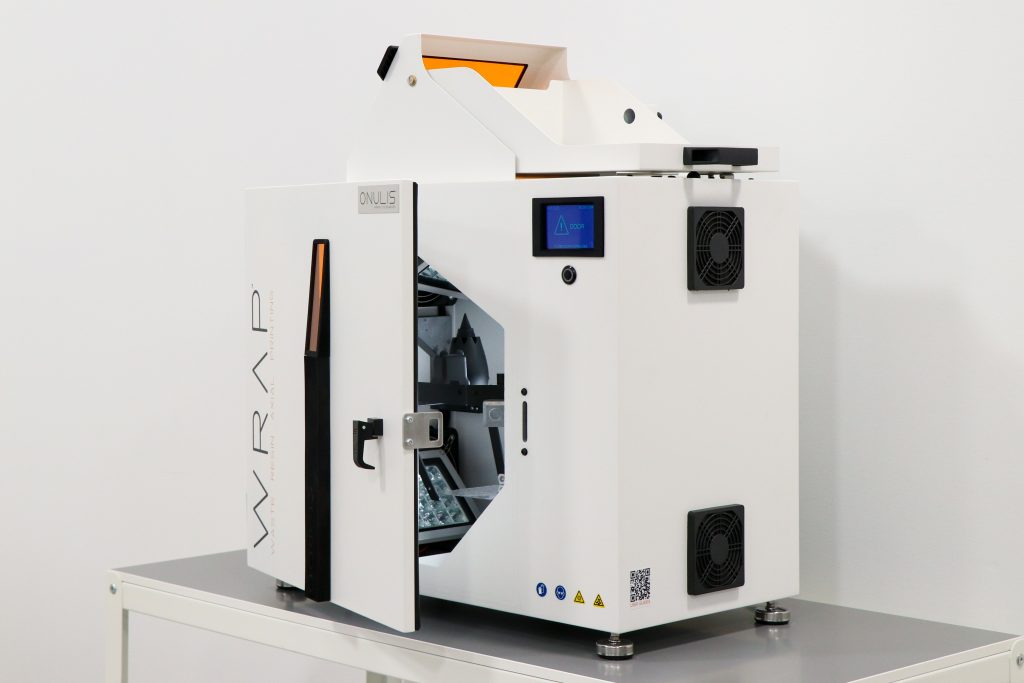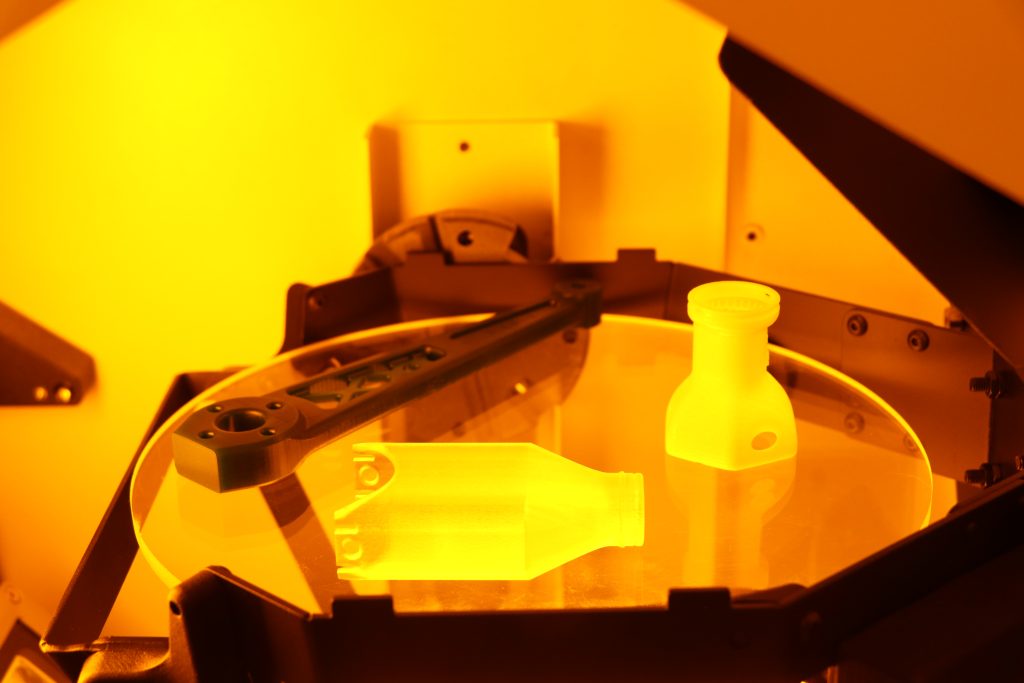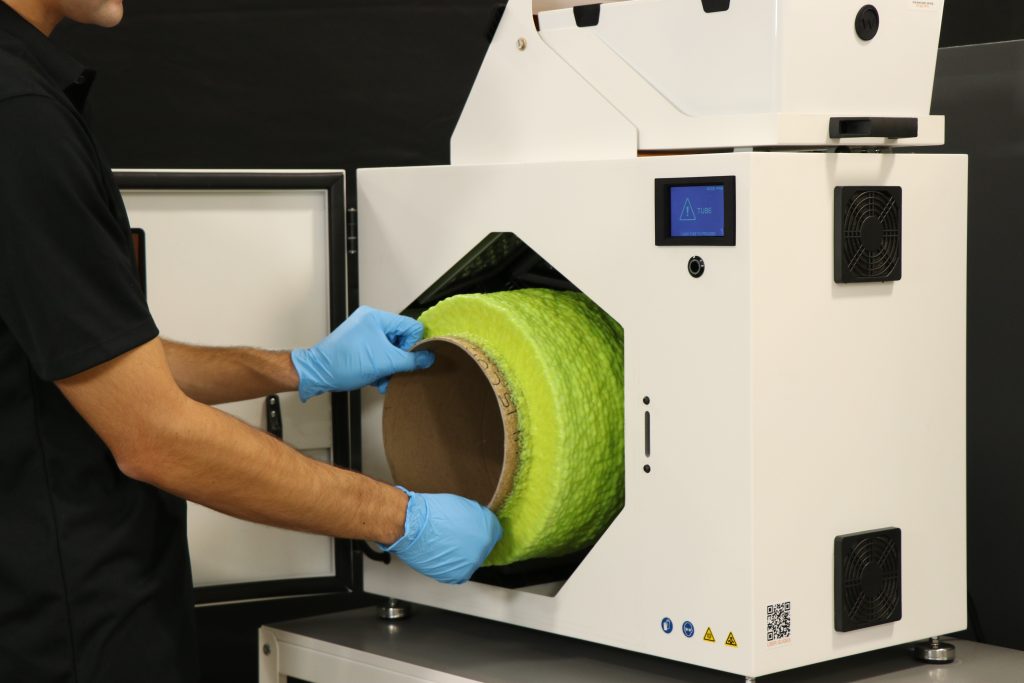Resin printing system manufacturer Onulis has announced the launch of the WRAPCure, a dual-function device that automatically post-cures Digital Light Processing (DLP) printed parts and repurposes waste resin.
Onulis’ original WRAP product line automatically converts used UV resin into fully-cured plastic stock, resulting in materials that can be CNC machined, and are safe for disposal as standard household waste. As such, the machine is designed to offer a cost-effective, eco-friendly alternative to hazardous waste disposal methods.
The new WRAPCure retains all of the sustainable waste printing features of the WRAP, but adds the ability for users to post-cure DLP parts as well.

Automating the curing workflow
All DLP 3D printed parts must be post-cured to ensure desired mechanical properties and dimensional accuracy. However, when it comes to post-curing, Onulis says current options still “fall short” of user needs, hence it has launched the WRAPCure, the “only DLP curing system that automatically cures all sides of the part simultaneously.”
That’s not to say there aren’t automated post-processing options on the market, some of which incorporate rotating tables. But as the firm points out, these solutions don’t allow UV light to penetrate the underside of parts, requiring operators to manually reposition parts for complete curing. Likewise, these solutions often use metal halide bulbs which produce excessive heat, thus they require constant monitoring and adjustments to prevent any overheating and product warpage.
With these drawbacks in mind, Onulis has identified a gap in the market for a solution that “automatically cures parts quickly and effectively,” and allows engineers to “focus on high-priority tasks,” rather than manual, tedious adjustments.

Onulis’ dual-functional WRAPCure
To address this market need, Onulis has built the WRAPCure with a unique elevated turntable, positioned between upper and lower high powered UV lights, which enables the complete and controlled curing of DLP parts without the need for manual flipping.
Onulis has also integrated long-lasting LED lighting into the system to provide the ideal curing wavelength, instead of the expensive metal halide bulbs found in older technologies. This, in combination with the machine’s microprocessor, which precisely controls the temperature and duration of every build, is said to allow users to optimize on material properties and dimensional accuracy.
The WRAPCure’s large platform, meanwhile, allows for the post-processing of both small and oversized parts, and when DLP part curing is complete, the system can be converted back into a waste resin printer in under 60 seconds.

Validated performance
Since its introduction, the WRAP has been marketed as a more cost-friendly, sustainable alternative to the use of cumbersome hazardous waste services. Onulis states that it has been fortunate to provide its technology to clients ranging from academics to medical device developers, and adopters like Google that have hailed it as being, “great for the shop and the environment. Fill it and leave it, you have the peace of mind that excess material is being handled right and safely.”
Onulis adds that the new system’s dual functionality, which enables part curing and waste resin printing, make it an excellent value addition for manufacturers and its price is that of single-function DLP curing offering.

Technical specifications and pricing
Below are the technical specifications for the Onulis WRAPCure system. Those interested can purchase on the Onulis website.
| Waste Printing Compatibility | PolyJet, MultiJet, SLA, DLP |
| Post-Processing Compatibility | All DLP Printed Parts |
| Changeover Time | 60 Seconds |
| UV Energy Source | 405nm Wavelength 60 Watt LED |
| System Size | 26.5” x 16.5” x 28.7” |
| Operating Conditions | Temperature 65 – 95°F |
| Power Requirements | 100 – 120 VAC, 50 – 60 Hz |
| Optional Storage Stand Size | 28” x 17.5” x 22” |

To stay up to date with the latest 3D printing news, don’t forget to subscribe to the 3D Printing Industry newsletter or follow us on Twitter or liking our page on Facebook.
While you’re here, why not subscribe to our Youtube channel? featuring discussion, debriefs, video shorts and webinar replays.
Are you looking for a job in the additive manufacturing industry? Visit 3D Printing Jobs for a selection of roles in the industry.
Featured image shows the Onulis WRAPCure in DLP post-cure mode. Photo via Onulis.



